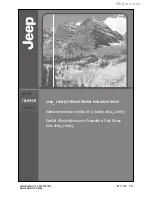
4. Set the
Switched Power Warm-up
time to 10 seconds. Modbus Register 1005 = 1000 (0.01 seconds × 1000 = 10
seconds).
5. Set the
Switched Power Voltage
to 16 volts. Modbus Register 1006 = 1.
9.5 Working with Solar Power
A reliable solar system requires careful planning and monitoring to size the components correctly. The recommendations
provided are for the DXM system as an autonomous system.
Adding extra components increases the power requirements and likely requires increasing the solar system components.
Depending upon the geographical location, the size of the solar panel and battery may vary.
9.5.1 Setting the DXM for Solar Power
By default, the DXM is set from the factory to charge a backup battery from a line power source.
For DXM models with an LCD, use the buttons and menu system to change the charging algorithm to solar power. Go to
System Config
>
I/O Board
>
Charger
. Use the up/down arrows to select
Solar
.
For DXM models without an LCD, use the configuration software to adjust the I/O board Modbus register 6071. Set the
register to 0 to select battery charging from a solar panel, and set to 1 to select battery charging from incoming 12 to 30 V DC
supply.
To minimize the power consumption (may not apply to all models):
•
If Ethernet is not being used, save up to 25% of the consumed power by disabling Ethernet. Set DIP switch 1 to the
ON position on the processor board then reboot.
•
Instead of powering external devices all the time, take advantage of the switched power mechanisms to turn off
devices when possible.
•
Minimize the number of cellular transactions and the amount of data pushed across the cellular modem.
9.5.2 Solar Components
The components of a solar system include the battery and the solar panel.
Battery
The DXM solar controller is designed to use a 12 V sealed lead acid (SLA) battery. The characteristics of a solar system
require the battery to be of a certain type. There are two types of lead acid batteries:
•
SLI batteries (Starting Lights Ignition) designed for quick bursts of energy, like starting engines
•
Deep Cycle batteries - greater long-term energy delivery. This is the best choice for a solar battery.
Since a solar system charges and discharges daily, a deep cycle battery is the best choice. There are different versions of a
lead acid battery: wet cell (flooded), gel cell, and an absorbed glass mat (AGM).
Wet cell batteries are the original type of rechargeable battery and come in two styles, serviceable and maintenance free.
Wet cell batteries typically require special attention to ventilation as well as periodic maintenance but are the lowest cost. The
gel cell and AGM battery are sealed batteries that cost more but store very well and do not tend to sulfate or degrade as
easily as a wet cell. Gel or AGM batteries are the safest lead acid batteries you can use.
Battery capacity
is a function of the ambient temperature and the rate of discharge. Depending upon the specific battery, a
battery operating at –30 °C can have as much as 40 percent less capacity than a battery operating at 20 °C. Choose enough
battery capacity based on your geographical location.
Table 33: Average voltage readings relative to battery charge
State of Charge (%)
Open Circuit Voltage
100
13.0 or higher
75
12.6
50
12.1
25
11.66
0
11.4 or less
A larger capacity battery typically lasts longer for a given solar application because lead-acid batteries do not like deep
cycling (discharging a large percentage of its capacity). Depending upon the battery, a battery discharging only 30 percent of
its capacity before recharging will have approximately 1100 charge/discharge cycles. The same battery discharging 50
Sure Cross
®
DXM100-Bx and DXM1000-Bx Wireless Controllers
86
www.bannerengineering.com - Tel: + 1 888 373 6767
















































